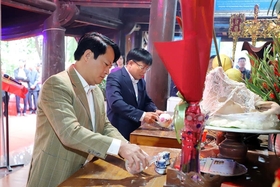{title}
{publish}
{head}
As one of the oldest ethnic groups living in the ancestral land, the Muong people of Yen Lap district have preserved their traditional identities in language, clothing, and especially in the uniqueness of their food, with the leaf feast being a prime example.

Over time, with the changes in life, the traditional dishes in the leaf feast are still maintained in the daily life of the Muong people of Yen Lap.
In a typical leaf feast, there are always a variety of dishes made from pork, chicken, fish, stone crabs, vegetables, and fruits—ingredients harvested from their farms and forests. A special dish that is always present is the five-color sticky rice, symbolizing the five elements of Yin and Yang, as well as the unity of the Muong ethnic community in particular and all ethnic groups in the district in general. The sticky rice is made from a special type of glutinous rice called Ga gay, which has a fragrant aroma of the mountain herbs. The rice grains are plump, shiny, and even, and even when cooled, the rice remains soft, chewy, and never loses its delicate texture. This makes the five-color sticky rice truly unique compared to other types of sticky rice.
Along with the meat dishes, there are boiled bamboo shoots and various wild vegetables. The wild vegetables are washed, placed into a bamboo tube or steamed for about 30 to 40 minutes. The steamed wild vegetables are served with a special dipping sauce made from fermented rice vinegar, and when eaten, one can taste the bitterness, astringency, sweetness, richness, and spiciness of the vegetables blending together. This is also a very healthy dish, and it still frequently appears in the Muong people’s family meals.

The most impressive dish is the grilled fish called “Ngoi Lao” from the Muong people here. The fish is caught by hand, cleaned, and drained. It is then marinated with spices, skewered with bamboo sticks, and grilled over charcoal until golden brown. The grilled fish is spread out on banana leaves, and when hot, the smell of the grilled fish combined with the fragrance of the banana leaves creates an irresistible aroma that stimulates both the sense of smell and taste.
Mr. Nguyen Tam Ba, Chairman of Xuan An Commune People’s Committee, shared: "The dishes in the ’mam co la' (leaf platter) are foods that have been formed during the labor process of the ethnic people. The ingredients are carefully prepared, becoming unique dishes of the Muong people. The Muong people see arranging the ’mam co la' to entertain guests as a display of love, unity, and hospitality. The leaf platter, imbued with the flavors of the mountains and forests, is always arranged meticulously in a circular shape with a variety of dishes, representing the harmony of heaven and earth, along with the wish for abundance, completeness, prosperity, peace, and health of the Muong people."
Through the leaf platter, the Muong people demonstrate their sense of community, mutual affection, family values, and their unique culture. The leaf platter is considered one of the distinctive cultural features of Muong cuisine in Yen Lap during festivals, traditional cultural celebrations, and holidays.
Thu Giang

baophutho.vn Phu Tho—the land of national origins—is home to more than 1,064 valuable historical and cultural relics. In recent years, efforts to enhance...

baophutho.vn In Yen Luong Commune, Thanh Son District, the only Tho ethnic community in Phu Tho Province has lived in harmony and unity for over half a...

baophutho.vn Not "emerging" from ancient legends, nor a rare and hard-to-find delicacy, Phong Chau cassava cake is a simple, traditional gift from the...

baophutho.vn The craft of making banh chung and banh giay in Viet Tri city and the districts of Cam Khe and Tam Nong (Phu Tho province) has been recognized...

baophutho.vn Before Christmas, many churches in the province are brightly decorated and lit up. Among them, the ancient church of No Luc Parish, Thuy Van...

baophutho.vn On December 4, the People’s Committee of Doan Hung District coordinated with Hung Vuong University to organize a workshop: Restoring and...

baophutho.vn Xoan singing, also known as Khuc Mon Dinh (singing at the communal house yard), is a way of singing to worship gods. Singing at the communal...

baophutho.vn On December 2 (i.e., November 2 of the lunar calendar), the District Party Committee, People’s Council, People’s Committee, and Fatherland...

baophutho.vn On November 28, the opening ceremony of the exhibition and performance of UNESCO-recognized cultural heritage took place at the Ha Tinh...

baophutho.vn On November 28, the Phu Tho Provincial Party Committee, Central Propaganda Department, and Vietnam Academy of Social Sciences jointly organized...

baophutho.vn On the evening of November 25, at the Cultural Center of Nghe An province, the closing ceremony of the exhibition “Colors of cultural heritage,...

baophutho.vn The traditional brocade weaving craft of the Muong people is a unique and distinctive cultural feature, occupying an important position in the...